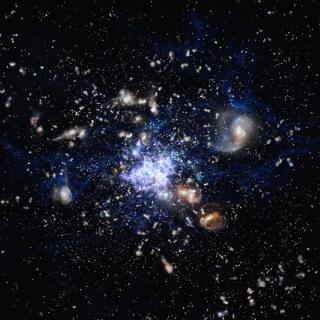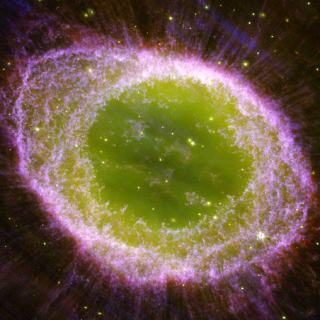The Sun is not the live coal that Anaxagoras described. We can imagine hell in its interior, and we know that there are darker spots on its surface which, when discovered, were shown to be incompatible with the Aristotelian principle of the perfection of the heavenly bodies. We have learned a great deal about our star since then, but even now we do not know the answer to some important questions about the source of energy of our Solar System, the main source of life. These were the words of Jeffrey R. Kuhn, doctor in Physics from Princeton University, and currently Professor at the Institute of Astronomy at the University of Hawaii, who gave a talk at the Instituto de Astrofísica de Canarias (IAC) about the observations of the solar corona which will be made with the Daniel K. Inouye Solar Telescope (DKIST) planned for Hawaii. This is the astronomer who is in charge of that telescope, which will be used to measure the magnetic field in the solar corona. As well as obtaining a better understanding of the Sun, Kuhn also thinks, as he said in his colloquium to researchers at the IAC, that we are likely to find life outside the Solar System within a decade, although this will need optical telescopes which can make direct images of expolanets, such as specialized telescopes with diameters in the range 20-100 metres.
1. You were one of the speakers of the IAC Winter School of 1994 dedicated to the structure of the Sun. What have we learned from the Sun since then and what do we have left to learn?
Very interesting question, so 1994, it has been more than 20 years now. Those were the early days of Helioseismology and the big change since then is that Helioseismology is a mature field now and not only is it a complete tool for the sun but it has become a complete tool for understanding other stars. Back then we had no idea that we would be able to use these tools to extend our knowledge of the interiors, not just of the sun, but the interiors of other stars. So I think one of the most exciting developments was that transition. For the sun we now know very well about the interior rotation that we did not know very well before. We have begun, and most people would say we have solved, the problem of why the sun rotates differentially, we understand the interaction of convection and rotation. There are still some mysteries, the mystery of what happens with the rotation of the surface of the sun and why it slows down is a very large mystery and there are now many problems that remain in trying to understand how the magnetic field makes its way out into the corona. So there are still plenty of problems to deal with but I would say that the subject of that one school was very important because it was the early days of the field of Helioseismology which played a very big role in the development of, I think, the IAC and what the IAC does.
2. A recent study by Queen's University and the IAC published in Nature Astronomy gave an explanation of why the solar corona is hotter than the surface? Has one of the enigmas that for decades brought head-to-head physicists been solved?
I think that that they are on the right track but I would say that we still have not completely unraveled that problem. We know that it is magnetic energy that is heating the corona and we know that it is related to the waves, but I think that the verdict is still out on exactly how the magnetic energy gets converted into heat and so, I think, that this is a very important step forward but it is not finished.
3. To what extent will what we know about the Sun depend on instrumentation and large telescopes?
There is a very large jump in our ability to study the Sun coming hopefully from here with the European Solar Telescope but on the other side of the world the Daniel K. Inouye telescope that will come on line in about 6 months and it will be open for business. That telescope is unusual in that it has really been designed to look at the corona, it has the capabilities of being a chronograph blocking the light of the disk of the sun and seeing the very faint corona and one of the first light instruments is an instrument I am responsible for called the Cryogenic Near Infrared Spectrograph and its job is to measure the magnetism, its primary science goal, will be from the beginning to measure the magnetic field of the corona of the sun and understand how it actually does create the transfer, the energy of magnetism into the energy of heat. I think that when the European, and other solar telescopes come online, they will be focused on very detailed questions related to the magnetism of the disk of the Sun. And those are things that we still are struggling with because the difficulty of the magnetic field problem is that the magnetism exists on all spatial scales which are all interconnected, and the interconnection has proved to be difficult. So we need what is going on both over in Hawaii and in this other telescope here.
4. What is expected of the Daniel K. Inouye Solar Telescope that will be in operation soon and how will it be complemented by the European Solar Telescope EST, which will be installed in the Canary Islands?
Because they are 10 or 11 time zones apart, they give us the opportunity of tracing and following the dynamic magnetic structure essentially continuously. The Sun unfortunately continues to work at night when we cannot see it in Hawaii and so the ability, when we do look at the disk of the Sun, to combine what happens here with what we can see over there I think this is going to be a wonderful development.
5. The colloquium you gave here covered the future of exoplanet research with the generation of telescopes that will follow the TMT, EELT and GMT. Will we get direct images of an exoplanet? And proof of life beyond the Solar System?
I think that in our lifetime we are going to wake up some morning up to the news that w have discovered life. And it is my personal view that life is not very rare at all. You know in astronomy and life, we spend our lives thinking that were very special. From the time our mothers and our fathers cradle us in their arms, we think the world is small and that we are the center of it. We spend our lives thinking on we are special and, in this way, it is not very different in astronomy. In astronomy we have learned how unspecial the Earth was. When I was a graduate student I was told by my professors that conditions to form planets were so rare that it is very unlikely that there are other planets in the galaxy or even the universe and of course that´s wrong. Around most stars there is at least one planet and I think we should take that lesson to heart and recognize that life probably also is not very rare and unusual and the only reason why we have not seen it is because we have not had that capability, even the biggest telescopes we are building now, the EELT or the TMT or the GMT, will have a very difficult time finding signatures of life.
We should be building a telescope which is not directed to doing all astronomy but which is directed at forming, basically, images of exoplanets. The telescope can be big enough that it can make a picture directly but the combination of using what we call inversion tools and separating the light of the planet from the star will allow us to make pictures of exoplanets. And I think that is going to happen and the technology for those telescopes is different because it is not a telescope that does everything for everybody, it will not do supernova research, it is not optimal. The TMT or the EELT will cover that, but this is a telescope that would spend all of its time to understand exoplanets, understand life. And it would be different in the way that it works through several different technologies that are just becoming available now. I would say that the technologies are there but they haven´t been demonstrated, so a very important step is to build a precursor, we call it a Hybrid Optical Telescope, it is a telescope that combines elements of a conventional telescope like the Gran Telescopio Canarias (GTC) with elements of interferometry and we have simulated and demonstrated how that could work, but we really need to go to the sky and demonstrate it and I think we could do that within a couple of years if we dedicate the energy and resolve. And that is what we are trying to do.
6. Do you think that the problems in Hawaii will be solved in order to install the TMT there or that this telescope will finally be installed on La Palma?
That is difficult, so I am old enough to know and understand that the hardest problems in doing science are related to people, it is not the technology and it is not even the theory or the calculations or the data analysis are its problems, it is the people. And I would say that none of the astronomers, I do not spend much time on Maunakea but you are right I work with the astronomers that do, none of us anticipated that the people problems would be so difficult with the TMT. I do not know the answer; I think right now the entire situation is a stalemate. So you have this side and the other side staring at one another and they are just waiting for someone to back down. I do not think that the Hawaiian groups that are camped on the mountain are going to back down. And I also do not understand or believe that the governor of the state of Hawaii is going to go away, so I do not know what that means. It could mean that the telescope will be built somewhere else. Then the situation in Hawaii is very complicated and I think none of us, the problem was that none of us in the astronomy world knew how complicated it really was and we kind of discovered that as it took place. I am just grateful that on Haleakala, we have completed this major solar telescope and that we were delayed for 4-5 years when the environment would have been much more difficult to finish it.
7. To what extent is the conflict with the Hawaiian indigenous population affecting other facilities present and future in Hawaii?
My belief is that this will be resolved in time, and regardless of the future of the TMT I think people will, with some time, find common ground and realize that there is respect on both sides. The university of Hawaii is very much an inclusive university of the Hawaiian culture and the local cultures that have been there only over the last 100 years. I think it is a matter of time and everyone is working towards that understanding. So I am optimistic.



